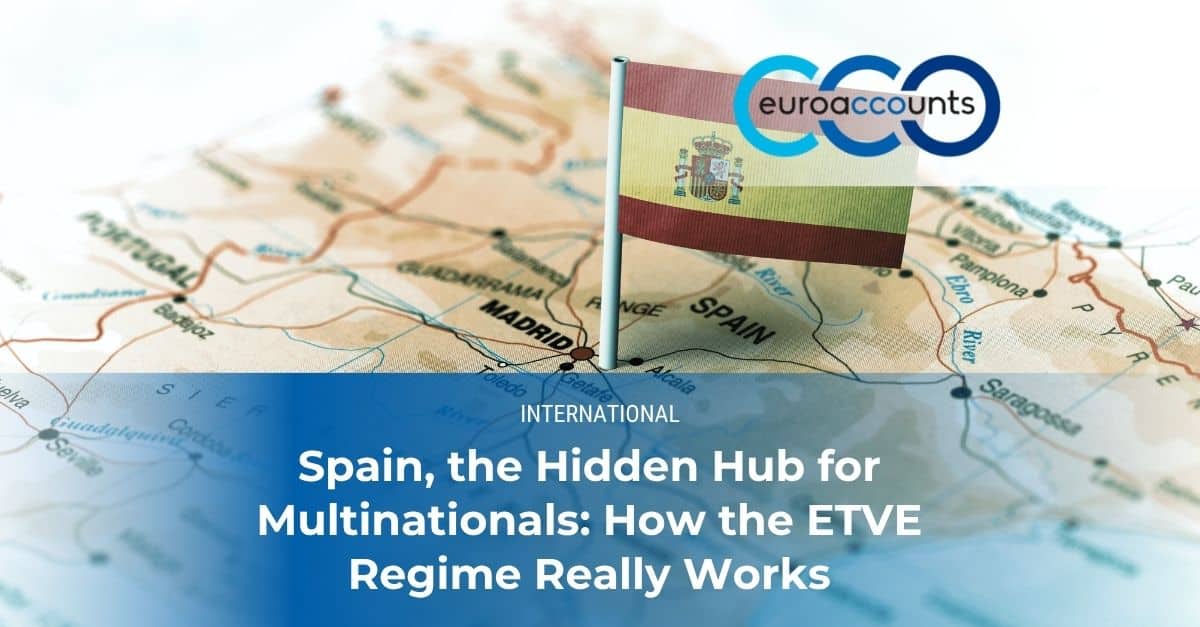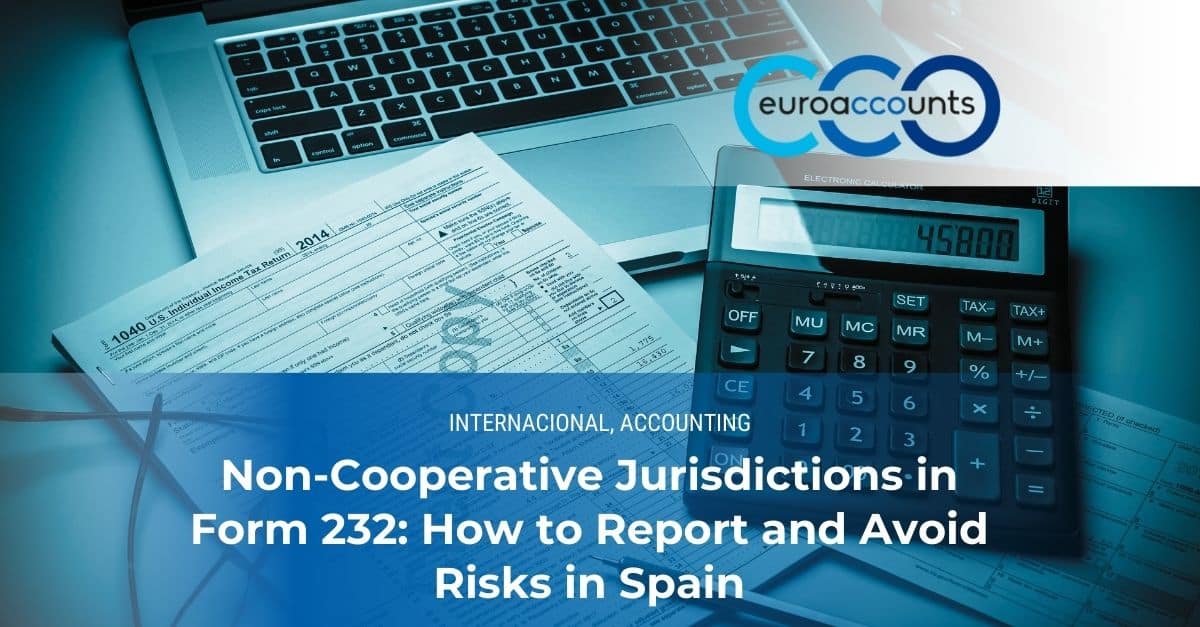International double taxation is a critical challenge for multinational groups operating in Spain. When the same income—such as dividends paid by a Spanish subsidiary to its U.S. parent company—is taxed in both the source and destination countries, the tax burden can increase by up to 30% if not managed properly. Additionally, errors in handling this issue heighten the risk of penalties or audits by the Spanish Tax Agency (AEAT).
In this guide, we explain how to avoid double taxation using double taxation treaties (DTTs), the Spanish Corporate Income Tax exemption regime, and strategic tax planning. We also detail its connection to Form 232, essential for reporting related-party transactions like royalties or dividends.
Are you managing a Spanish subsidiary or overseeing an international group? Discover how to minimize risks and optimize your tax strategy.
What is Double Taxation and How Does It Occur?
Definition and Types: Economic vs. Juridical
Double taxation occurs when the same income is taxed multiple times by different tax jurisdictions or entities. There are two main types:
- Juridical double taxation: Two countries tax the same income in the hands of the same taxpayer (e.g., a French parent and its Spanish subsidiary taxing a dividend).
- Economic double taxation: Two entities within the same corporate group are taxed on the same income (e.g., a subsidiary and its parent on an intra-group payment).
The AEAT uses audits to detect inconsistencies in these transactions, which can lead to tax adjustments or penalties.
Common Issues for Multinational Groups
Multinationals often face challenges such as:
- Dividends taxed in Spain and again in the parent company’s country.
- Interest on intra-group loans subject to withholding at source and additional taxation in the destination country.
- Royalties misreported due to missing valid tax residency certificates.
Example 1: A Spanish subsidiary pays €500,000 in dividends to its U.S. parent. Without applying the DTT, it faces a 19% withholding tax in Spain (€95,000), plus taxes in the U.S.
Example 2: A Spanish subsidiary pays €200,000 in interest on an intra-group loan to its Japanese parent. Without the Spain-Japan DTT, the withholding is 19% (€38,000), but with the DTT, it drops to 0%.
Double Taxation Treaties (DTTs) Applicable in Spain
Exemption and Tax Credit Mechanisms
Spain has signed double taxation treaties (DTTs) with over 90 countries to prevent income from being taxed twice. The main mechanisms are:
- Exemption: The recipient’s country of residence exempts income already taxed in the source country (ideal for dividends under Article 21 of the Spanish Corporate Income Tax Law, LIS).
- Tax credit: Taxes paid abroad are deducted from the tax due in the residence country, up to the local tax limit.
The choice between exemption and tax credit depends on the DTT and the type of income (dividends, interest, royalties).
Key Countries (France, Germany, U.S., Netherlands)
Below is a table with maximum withholding rates under relevant DTTs:
| Country | Dividends (DTT) | Royalties (DTT) | Interest (DTT) |
|---|---|---|---|
| France | 0% (≥5% ownership) | 0% | 0% |
| Germany | 15% | 0% | 0% |
| U.S. | 0–15% (≥10% ownership) | 0% | 0% |
| Netherlands | 0% (≥5% ownership) | 0% | 0% |
Note: To apply these reductions, a valid tax residency certificate issued by the recipient country’s tax authority is required, effective at the time of payment.
Key Clauses: Permanent Establishment, Dividends, Royalties
DTTs include critical provisions:
- Dividends: Require a minimum ownership (e.g., 10% for the U.S.) for reduced rates.
- Royalties and interest: Most DTTs reduce withholding to 0% if the beneficial owner is a resident of the treaty country.
- Limitation of benefits: Prevents treaty abuse if the entity lacks economic substance (e.g., no offices, employees, or real activity).
Example: A parent company in a non-cooperative jurisdiction cannot benefit from the Spain-Netherlands DTT without proving economic substance, such as an operational office with employees.
Check the updated list of DTTs on the AEAT website: www.aeat.es.
Exemptions and Alternative Methods: Spain’s Exemption Regime
Exemption System for Double Taxation (6 Pillars, Articles 21-29 LIS)
Spain’s Corporate Income Tax Law (LIS, Articles 21-29) offers an exemption regime to avoid international double taxation on dividends and gains from foreign entity participations. The key requirements are:
- Minimum ownership: ≥5% of capital or acquisition value >€20M.
- Continuous holding: ≥1 year (before or after distribution).
- Equivalent taxation: The foreign entity must be subject to a tax similar to Spain’s Corporate Income Tax (≥10% nominal rate).
- Real business activity: The entity must not be a passive holding company.
- Not in non-cooperative jurisdictions: Unless economic substance is proven.
- Documentation: Evidence of compliance (financial statements, contracts, certificates).
Example: A Spanish subsidiary receives €500,000 in dividends from a German sub-subsidiary with a 10% ownership held for 2 years. Meeting Article 21 LIS requirements, it is exempt from tax in Spain.
Withholding vs. Deduction in Payments
If the exemption does not apply, a tax credit allows deducting foreign taxes paid, up to the Spanish tax limit on that income.
Example: A Spanish subsidiary pays €100,000 in dividends to a parent in a non-DTT country, withholding €19,000 (19%) in Spain. This amount is deducted in Form 200 up to the Spanish tax limit.
Both methods require technical documentation (certificates, accounting records) to avoid AEAT adjustments.
Transparency and Effective Control Conditions
The AEAT requires the foreign entity to have economic substance, meaning offices, employees, and real activity, not just a tax avoidance vehicle. Effective control implies the group actively oversees the participated entity.
Example: A parent in a non-cooperative jurisdiction with a Spanish subsidiary must prove it has employees and operational activity to benefit from the Article 21 LIS exemption.
Withholding Tax (WHT): Calculation and Compliance
Transactions Subject to Withholding (Dividends, Interest, Royalties)
Withholding tax (WHT) applies to income paid from Spain to non-residents:
- Dividends: Standard 19% withholding. Exempt under the EU Parent-Subsidiary Directive (≥10% ownership).
- Interest: 19%, unless exempted by DTT or EU regulations.
- Royalties: 24% (or 19% in some cases), reducible to 0% with DTT.
Example: A Spanish subsidiary pays €200,000 in royalties to its Dutch parent. With the DTT and a valid residency certificate, the withholding is 0%.
Thresholds, Reporting Obligations, and Form 232
Transactions subject to WHT must be reported in:
- Form 232: Related-party transactions (≥€250,000 per transaction type) or with non-cooperative jurisdictions (≥€36,000).
- Form 210: Income of non-residents subject to withholding.
- Form 296: Annual report of withholdings on non-residents.
Example: A Spanish subsidiary pays €100,000 in royalties to its U.S. parent. With the DTT, the withholding is 0%. If exceeding €250,000, it must be reported on Form 232.
Read our Form 232 guide for more details.
Common Errors and Penalties for Incorrect Withholdings
Common errors include:
- Failing to apply DTTs due to missing residency certificates.
- Inconsistencies between Form 232 and Forms 210/296.
- Omitting related-party transactions on Form 232.
Penalties:
- €1,000 per incorrect or omitted data on Form 232 (minimum €3,000 per return).
- 1% of the value of unreported transactions (e.g., €1,000 for a €100,000 omitted royalty).
- Tax adjustments on Form 200 if withholdings do not reflect market value.
Tax Planning Between Parent and Subsidiary
Transfer Pricing Models and Intra-Group Adjustments
Effective tax planning requires aligning intra-group transactions with OECD arm’s length principles and Spanish regulations. Accepted valuation methods include:
- Comparable Uncontrolled Price (CUP): Compares prices with independent transactions.
- Cost Plus: Adds a margin to the cost of goods or services.
- Transactional Net Margin Method (TNMM): Analyzes the net margin of a transaction (e.g., intra-group services) for comparability.
Poor valuation can lead to primary adjustments by the AEAT, impacting the Form 200 taxable base and triggering penalties on Form 232.
Efficient Structures: Dividends, Loans, Royalties
Common strategies to optimize tax burdens:
- Intra-group loans: Market-based interest rates, with 0% withholding under DTTs.
- Royalties: Internal licenses in DTT-favorable jurisdictions (e.g., Netherlands).
- Dividends: Repatriated with exemption (Article 21 LIS) or reduced withholding under DTTs.
Example: A Spanish subsidiary licenses a patent to its Dutch parent, applying a 5% royalty justified by the CUP method, with 0% withholding under the DTT.
Fictitious Case: European Group Optimizes Tax Structure
A tech multinational with a German parent and Spanish subsidiary structured a €1,000,000 intra-group loan at a 2.5% interest rate, justified by the TNMM. Under the Spain-Germany DTT, withholding was 0%, saving €19,000 in WHT. The transaction was documented in the Local File and reported on Form 232, ensuring compliance.
Warning: Without proper documentation, the AEAT could adjust the interest to 3.5% (market value), increasing the Form 200 taxable base and imposing penalties.
Benefits of International Specialized Tax Advisory
Expertise in Treaties, Multilingual Support, and HQ-Spain Coordination
Multinationals need advisors who master DTTs, speak the parent’s language, and understand AEAT requirements. EUROACCOUNTS provides support in Spanish, English, and French, facilitating joint meetings between the Spanish subsidiary and parent to ensure clarity in DTT application.
Integration with Tax Reporting (Form 200, 232, TP File)
We connect advisory services with key tax forms:
- Form 232: Related-party transaction reporting.
- Form 200: Corporate Income Tax.
- Local File and Master File: Transfer pricing documentation.
Example: We automate royalty data extraction from SAP for reporting on Forms 232 and 200, minimizing errors.
Audits, Inspections, and Tax Risk Mitigation
EUROACCOUNTS anticipates risks and prepares robust documentation. For instance, we helped a U.S. pharmaceutical group correct royalty withholding errors, avoiding a €20,000 penalty and aligning Forms 232 and 296. We’ve supported over 50 multinationals in AEAT audits, ensuring DTT and transfer pricing compliance.
We automate data flows from ERP systems (SAP, Oracle NetSuite) with proper integrations, reducing errors and streamlining compliance. Form 232 must be filed in Spanish, but our multilingual support simplifies preparation.
From Risk to Control: Your Roadmap for Transfer Pricing
Avoiding double taxation requires more than applying tax treaties—it demands strategic planning, robust documentation, and comprehensive compliance. EUROACCOUNTS integrates DTTs, transfer pricing, and tax forms (200, 232, TP File) to ensure security and efficiency before the AEAT. Effective planning can reduce your group’s tax burden by up to 20%, depending on transaction volume.
Contact EUROACCOUNTS for a free consultation and elevate your international group’s tax strategy.
Frequently Asked Questions About Double Taxation Between Parent and Subsidiary
What is the difference between economic and juridical double taxation?
Juridical occurs when two countries tax the same income of one taxpayer. Economic affects two group entities on the same income.
When can the Article 21 LIS exemption be applied in Spain?
With ≥5% ownership (or €20M), ≥1-year holding, equivalent taxation (≥10% nominal), real activity, and no non-cooperative jurisdictions.
What certificates are needed to apply a double taxation treaty?
A valid tax residency certificate issued by the recipient country’s tax authority, effective at the time of payment.
Do all transactions with subsidiaries need to be reported on Form 232?
Only if they exceed thresholds: €250,000 (related-party transactions per type), €100,000 (specific transactions), or €36,000 (non-cooperative jurisdictions).
What are the benefits of specialized advisory like EUROACCOUNTS?
Technical security, multilingual support, ERP automation, and audit expertise to optimize taxation and avoid penalties.





